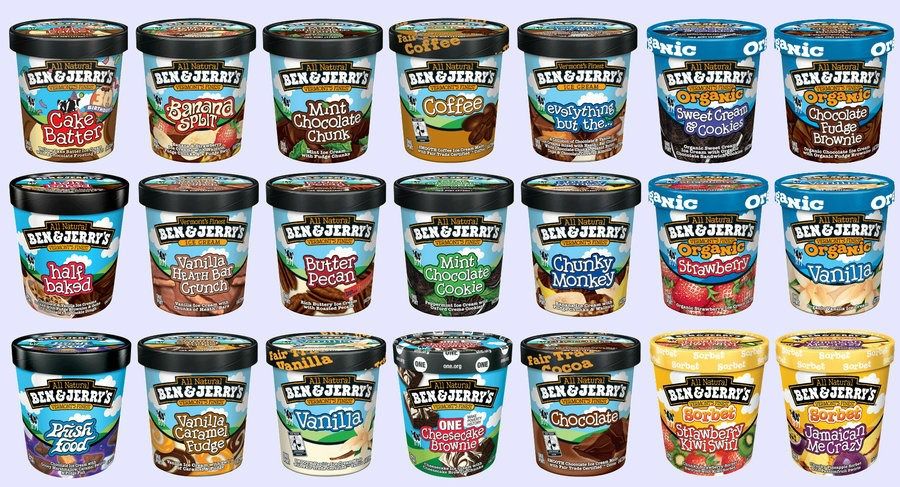The Vermont brand has been built on a bucolic image of cows grazing on endless pasture… Ben & Jerry’s ice cream and other Vermont companies have used this idyllic imagery to sell their products. Gone are the days, however, when most of Vermont’s cows were grazing in spectacularly scenic landscapes. Now a majority of Vermont’s cows are locked up in . . . ‘confined animal feeding operations’ or CAFOs . . . grazing on concrete with a diet rich in GMO corn and pesticides. – “Vermont’s GMO Addiction: Pesticides, Polluted Water and Climate Destruction,” Regeneration Vermont.
RELATED ARTICLE:
The most important thing we can do today as conscious consumers, farmers and food workers is to regenerate public health, the environment, and climate stability. We can do this most readily by moving away from industrial, GMO and factory-farm food toward an organic, pasture-based, soil-regenerative, humane, carbon-sequestering and climate-friendly agriculture system.
What’s standing in the way of this life-or-death transformation? Rampant greenwashing. The proliferation of $90 billion worth of fraudulently labeled or advertised “natural” and “socially responsible” food products in the U.S. confuses even the most well-intentioned of consumers and lures them away from purchasing genuine organic or grass-fed products.
Perhaps no company personifies greenwashing more than Vermont-based Ben & Jerry’s. Ben & Jerry’s history—a startup launched by two affable hippies, from a renovated gas station in Burlington, Vt., —is legendary. Despite selling out to Unilever in April 2000, the brand’s handlers have preserved its quirky, homespun image, and masterfully convinced consumers that Ben & Jerry’s has never strayed from its mission: “to make the world a better place.”
As the New York Times reports, the Organic Consumers Association (OCA) recently sent samples of Ben and Jerry’s top-selling ice cream brands to an independent testing lab for analysis. Ten out of 11 samples tested positive for Roundup (glyphosate and AMPA) herbicide contamination.
RELATED ARTICLE:
So much for making the world a better place.
Compare the Ben & Jerry’s test results with the results of our testing of organic brands, brands that use organic milk from farms that are actually making the world a better place. Three out of four nationally distributed organic ice cream brands tested negative for Roundup contamination (only Whole Foods “365” brand was contaminated).
A history of stalling on organic
Twenty-four years ago, anti-GMO food activists, including the Pure Food Campaign (OCA’s predecessor), successfully pressured Ben & Jerry’s and a number of other leading dairies to prohibit the use of America’s first genetically engineered food product, Monsanto’s recombinant Bovine Growth Hormone (rBGH). Now marketed by drug giant Elanco (Eli Lilly), rBGH is linked to increased risk of human breast and colon cancer, a greater use of antibiotics in animal feed, and damage to cow’s health.
Several groups, including the OCA, subsequently asked Ben & Jerry’s to move beyond just prohibiting their dairy cows from being injected with rBGH. We asked them to go 100 percent organic, which would have required the company to ban its dairy suppliers from feeding their cows GMO corn and grain and to use only organic ingredients in its flavors. But even before Ben & Jerry’s was bought out by Unilever, company founder Ben Cohen told Vermont Food activist Michael Colby “that Ben & Jerry’s was not going to transition to organic because it wouldn’t allow them to ‘maximize profits.’ “
Since 1994, Ben & Jerry’s, the $1.5-billion-per-year flagship brand of the second-largest multinational food corporation in the world, Unilever (annual sales $60 billion), has cashed in big time on its “rBGH-free” policy, advertising its brand, over and over again, as “all natural,” “GMO-free,” “fair trade,” “climate-just,” and “socially responsible.”
Despite repeated calls from consumer groups to stop advertising its ice-cream as “natural” or “all natural,” given that it is derived from cows raised almost exclusively on GMO corn forage (grown with Roundup Ready, neonic-, and BT-spliced seeds), laced with non-organic ingredients, sprayed heavily with Roundup and other pesticides, Ben & Jerry’s continues to greenwash and lie. The company recently (June 18, 2017) described its mission as:
To make, distribute and sell the finest quality and euphoric concoctions with a continued commitment to incorporating wholesome, ingredients and promoting business practices that respect the Earth and the Environment.
After more than a decade of dodging consumer, farmer, animal welfare, environmental and farmworker pleas to stop greenwashing and to equitably source its milk from cows grazing on organic pasture, Ben & Jerry’s continues to stall. Instead, Ben & Jerry’s sources its milk from St. Alban’s, a 400-farmer dairy co-op that is increasingly dominated by large factory farm-type dairy operations. To feed their cows, farmers routinely spray tons of pesticides, including Roundup, atrazine and metolachlor, on fields of GMO corn grown from neonic-coated and BT toxin seeds. They also apply tons of soil-killing, climate-disrupting nitrogen fertilizers that pollute Vermont’s streams, rivers, and lakes.
Petitions and protests calling for Ben & Jerry’s to stop its suppliers from exploiting farm workers, confining dairy cows and driving small dairy farmers into bankruptcy, have produced nothing more than vague promises of “respecting the Earth” and supporting rural economic justice.
Enough is enough. Vermont and national public interest organizations have lost our patience. It’s time for Unilever and Ben & Jerry’s to move beyond greenwashing to decisive action. It’s time for Ben & Jerry’s to announce it will immediately begin transitioning to 100-percent organic. Otherwise conscious consumers have no choice but to launch a national and, if necessary, international protest campaign and boycott.
Vermont activists demand major changes from Ben and Jerry’s
Regeneration Vermont, a broad-based coalition of consumers and farmers, has repeatedly asked Ben & Jerry’s and Unilever to sign a six-point pledge to go 100-percent organic over a three-year transition period. Here’s what the groups want Ben & Jerry’s to pledge:
1. A transition away from GMO crops and toxic pesticides/fertilizers and toward regenerative organic agricultural methods.
2. Fair wages for farmers, including premiums based on regeneration benchmarks and assistance in the transition toward regenerative methods.
3. Economic justice for farm workers, fair and livable wages, decent housing and social and cultural dignity.
4. Adoption of climate remediation techniques, beginning with an emphasis on healthy soils and cover-cropping for carbon sequestration and erosion control.
5. Humane treatment of farm animals, a phase-out of confinement dairies and a transition back to grassland grazing and grass-based feed for ruminants.
6. Cleaning up and protecting our watersheds, streams, rivers, ponds, lakes, and groundwater.
A trail of toxins
Recent reports published by Regeneration Vermont reveal that Ben & Jerry’s suppliers, and Vermont and U.S. (non-organic) dairy farmers in general, have gone backward, rather than forward over the past 15 years in terms of environmental sustainability, food safety, nutrition, greenhouse gas pollution, water pollution, animal welfare, farm worker justice, and preservation of family farms.
Chemical fertilizer use has also almost doubled in Vermont since GMOs began to dominate the market 15 years ago.
So much for Monsanto’s claims that GMO crops would reduce the use of toxic pesticides and water- polluting and climate-destabilizing nitrogen fertilizers. Not to mention Ben & Jerry’s claim that it is “non-GMO” and “environmentally responsible.”
RELATED ARTICLE:
This is What you Do to your Home and Planet when you use Roundup
Among Regeneration Vermont’s finding are the following:
• An astounding 97 percent of Vermont’s field corn, the major component of a non-organic dairy cow’s diet, is now GMO (Roundup Ready, Bt-spliced, neonic seeds). This is the highest percentage of any state in the U.S.
• Herbicide use has increased over 100 percent-per-acre in Vermont since Monsanto’s GMO corn came on the market, with recent heavy use of atrazine, metholachlor, simazine, pendimethlin, glyphosate (Roundup), acetochlor, dicamba, and alachlor.
As Regeneration Vermont states in its report:
Regulators have determined that five of these eight most used herbicides [in Vermont] are possible or probable human carcinogens, the remaining three are suspected carcinogens. Seven of the eight are possible or probable endocrine disruptors (the other one is a suspected to be an endocrine disruptor). All eight have been determined by regulators and academics to cause birth or developmental defects and contaminate drinking water and public waters with dangerous chemicals that have long-term persistence. Atrazine, simazine, acetachlor, and alachlor have lost their registration in the EU, and are effectively banned.
The threat of #DirtyDairy and factory farms
Millions of health-minded Americans, especially parents of young children, now understand that cheap, non-organic, genetically engineered, industrial and factory farm food is hazardous. Not only does chemical- and energy-intensive factory farming destroy the environment, destabilize the climate, impoverish rural communities, exploit farm workers, inflict unnecessary cruelty on farm animals, and contaminate the water supply, but the end product itself is inevitably contaminated and inferior in nutritional terms, in this case in comparison to 100% grass-fed and organic milk and dairy.
America’s green-minded consumers understand that industrial agriculture poses a terminal threat to the environment and climate stability. A highly conscious and passionate segment of the population is beginning to understand that converting to non-chemical, non-genetically engineered, energy-efficient, carbon-sequestering organic/regenerative farming practices, and drastically reducing food miles by re-localizing the food chain, are essential preconditions for stabilizing our out-of-control climate and preparing our families and communities for future energy and resource shortages.
A critical mass of the global grassroots—consumers, farmers, activists—now realize that unless we act quickly, global warming and climate chaos will soon severely disrupt industrial agriculture and long-distance food transportation, leading to massive crop failures, food shortages, famine, war, and pestilence. Even more alarming, accelerating levels of greenhouse gases will soon push global warming to a tipping point that will melt the polar icecaps and possibly unleash a cataclysmic discharge of climate-destabilizing methane, now sequestered in the fragile arctic tundra.
Thanks to this growing consumer awareness—and four decades of hard work—the organic community has built up a $50-billion “certified organic” and $5-billion 100% grass-fed food and products sector that prohibits the use of genetic engineering and pesticides. The rapidly expanding organic products sector now constitutes more than 5 percent of total retail grocery sales (and 15 percent of fruits and vegetables), with an annual growth rate of 10-15 percent. Even taking into account a sluggish economy, the organic market, if we eliminate greenwashing and labeling fraud, could conceivably reach a “tipping point” of 20 percent of grocery sales in 2020.
The myth of “natural” remains a threat
As impressive as this $55 billion Organic and Grass-fed Alternative is, it remains overshadowed by an additional $90 billion in annual spending by consumers on products, such as B&J’s, fraudulently marketed as “natural,” “gmo-free,” “free range,” or “sustainable.”
Consumer surveys indicate that the overwhelming majority of Americans believe that “natural” products are “almost organic,” yet at the same time, much cheaper; the majority believes that “all natural” actually means that it is better than organics. Ben & Jerry’s is not the only brand greenwashing its products and impeding the growth of organic, 100% grass-fed and regenerative foods. But it is certainly among the most shameless.
In fact, all these “natural,” “all-natural” and “sustainable” products are neither backed up by rules and regulations, nor a third-party certifier. Most “natural” or conventional products—whether produce, dairy or canned or frozen goods—are produced on large industrial farms or in processing plants that are highly polluting, chemical-intensive and energy-intensive.
Perhaps fraudulently labeled “natural” foods such as Ben & Jerry’s wouldn’t matter so much if we were living in normal times, with a relatively healthy population, environment, and climate. Conventional products sold as “natural” or “nearly organic” would be just one more example of chicanery or unethical business practices.
But we are not living in normal times.
Demanding that fake natural brands and producers, such as Ben & Jerry’s, make the transition to organic is a matter of life or death. We’re tired of pleading and politely asking Ben & Jerry’s, Unilever and other greenwashers to please change their ways. It’s time to step up the pressure. Please join the growing boycott of Ben & Jerry’s ice-cream by signing this petition and by volunteering to join a local campaign team in your local community.
Ronnie Cummins is international director of the Organic Consumers Association.
*Article originally appeared at Organic Consumers Association.












